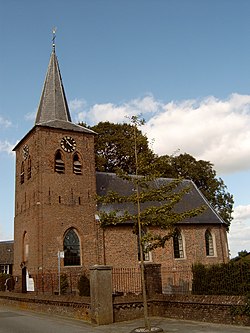Zevenaar
| Zevenaar | |||
|---|---|---|---|
| City and municipality | |||

Church in Lathum
|
|||
|
|||
 Location in Gelderland |
|||
| Coordinates: 51°55′N 6°4′E / 51.917°N 6.067°ECoordinates: 51°55′N 6°4′E / 51.917°N 6.067°E | |||
| Country | Netherlands | ||
| Province | Gelderland | ||
| Government | |||
| • Body | Municipal council | ||
| • Mayor | Jan de Ruiter (PvdA) | ||
| Area | |||
| • Total | 58.00 km2 (22.39 sq mi) | ||
| • Land | 53.26 km2 (20.56 sq mi) | ||
| • Water | 4.74 km2 (1.83 sq mi) | ||
| Elevation | 12 m (39 ft) | ||
| Population (May 2014) | |||
| • Total | 32,282 | ||
| • Density | 606/km2 (1,570/sq mi) | ||
| Demonym(s) | Zevenaarder | ||
| Time zone | CET (UTC+1) | ||
| • Summer (DST) | CEST (UTC+2) | ||
| Postcode | 6900–6909, 6986–6988 | ||
| Area code | 0313, 0316 | ||
| Website | www |
||
Zevenaar (![]() pronunciation ) is a municipality and a city in the Gelderland province, in the eastern Netherlands near the border with Germany.
pronunciation ) is a municipality and a city in the Gelderland province, in the eastern Netherlands near the border with Germany.
The earliest signs of human activity are remnants of a 700 BC settlement found near present-day Zevenaar. In 1049, Emperor Hendrik III donated a large amount of land to five warlords of which the leader was named Bartholomeus II of Sevenaer. They founded a castle to protect the old Roman settlements from the Germans.
In 1487, the duke of Cleves, a nearby town in Germany, gave Sevenaer city rights. Sevenaer was an important strategic point on the border of Gelderland and Germany. Some of the Castles and houses in Zevenaar have foundations dating back to the 14th Century Huize Sevenaer.
When Sevenaer obtained city rights it had the monopoly on markets and on sale of bread and beer with the surrounding towns. Also the jurisdiction in Sevenaer was founded, the town government was charging taxes so that the town could build roads, railways and public buildings. For the 500 inhabitants that was a heavy tax. Because of the plundering by several armies there were not enough supplies and money to build anything. Also contagious diseases ensured much embarrassment. In that time not the citizens but some well-to-do families got the right to participation in policy and government. Sevenaer then experienced a prosperous period. In 1793 the city had 900 inhabitants.
In 1816, Sevenaer became part of the Kingdom of the Netherlands. Two years later the old spelling of Sevenaer was changed to the current name: Zevenaar. The municipality then had 2564 inhabitants. The 19th century was a century of poverty, bad harvests, sicknesses and hunger. There was hardly trade and work. Many people lived by agriculture or from charity. In 1856, Zevenaar was connected to the European railroad system, which (just some decades later) led to the increase in workforce. In 1920, the cigarette factory Turmac came which insured much employment.
...
Wikipedia

